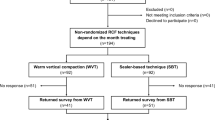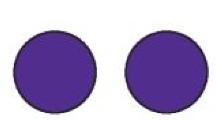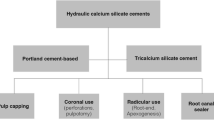Abstract
Objectives
To gain insight on the current clinical usage of bioceramic root canal sealers (BRCS) by general dental practitioners (GDPs) and endodontic practitioners (EPs) and to determine if BRCS clinical application is in accordance with the best available evidence.
Material and methods
An online questionnaire of 18 questions addressing BRCS was proposed to 2335 dentists via a web-based educational forum. Participants were asked about socio-demographic data, clinical practice with BRCS, and their motivation for using BRCS. Statistical analysis (chi-squared test or Fisher’s exact test) was applied, as appropriate, to assess the association between the variable categories (p value < 0.05).
Results
The response rate was 28.91%. Among respondents, 94.8% knew BRCS (EPs more than GDPs, p < 0.05) and 51.70% were using BRCS. The primary reason for using BRCS was their belief of its improved properties (87.7%). Among BRCS users, single-cone technique (SCT) was the most employed obturation method (63.3%) which was more applied by GDPs (p < 0.05); EPs utilized more of the thermoplasticized obturation techniques (p < 0.05). A proportion of 38.4% of BRCS users indicated the usage of SCT with BRCS regardless of the root canal anatomy (GDPs more than EPs p < 0.05) and 55.6% considered that BRCS may influence their ability to re-establish apical patency during retreatment (GDPs more than EPs p < 0.05).
Conclusions
This study highlights wide variation in the clinical use of BRCS which is not in accordance with the current literature.
Clinical relevance
This inconsistency among EPs and GDPs on BRCS clinical application requires further clarifications to better standardize their use and improve their future evaluation.



Similar content being viewed by others
References
Hülsmann M, Peters OA, Dummer PMH (2005) Mechanical preparation of root canals: shaping goals, techniques and means. Endod Top 10:30–76
Vertucci FJ (2005) Root canal morphology and its relationship to endodontic procedures. Endod Top 10:3–29
Tomson RME, Polycarpou N, Tomson PL (2014) Contemporary obturation of the root canal system. Br Dent J 216:315–322
Wu M-K, van der Sluis LWM, Wesselink PR (2006) A 1-year follow-up study on leakage of single-cone fillings with RoekoRSA sealer. Oral Surg Oral Med Oral Pathol Oral Radiol Endod 101:662–667
Ørstavik D, Nordahl I, Tibballs JE (2001) Dimensional change following setting of root canal sealer materials. Dent Mater Off Publ Acad Dent Mater 17:512–519
De-Deus G, Coutinho-Filho T, Reis C, Murad C, Paciornik S (2006) Polymicrobial leakage of four root canal sealers at two different thicknesses. J Endod 32:998–1001
Kaur M, Singh H, Dhillon JS, Batra M, Saini M (2017) MTA versus biodentine: review of literature with a comparative analysis. J Clin Diagn Res JCDR 11:ZG01–ZG05
Camilleri J (2017) Will bioceramics be the future root canal filling materials? Curr Oral Health Rep 4:228–238
Silva Almeida LH, Moraes RR, Morgental RD, Pappen FG (2017) Are premixed calcium silicate-based endodontic sealers comparable to conventional materials? A systematic review of in vitro studies. J Endod 43:527–535
Camilleri J (2015) Sealers and warm gutta-percha obturation techniques. J Endod 41:72–78
DeLong C, He J, Woodmansey KF (2015) The effect of obturation technique on the push-out bond strength of calcium silicate sealers. J Endod 41:385–388
Bjørndal L, Reit C (2005) The adoption of new endodontic technology amongst Danish general dental practitioners. Int Endod J 38:52–58
Savani GM, Sabbah W, Sedgley CM, Whitten B (2014) Current trends in endodontic treatment by general dental practitioners: report of a United States National Survey. J Endod 40:618–624
Setzer FC, Hinckley N, Kohli MR, Karabucak B (2017) A survey of cone-beam computed tomographic use among endodontic practitioners in the United States. J Endod 43:699–704
Donnermeyer D, Bürklein S, Dammaschke T, Schäfer E (2018) Endodontic sealers based on calcium silicates: a systematic review. Odontology. https://doi.org/10.1007/s10266-018-0400-3
Jafari F, Jafari S (2017) Composition and physicochemical properties of calcium silicate based sealers: a review article. J Clin Exp Dent 9:e1249–e1255
Atmeh AR, Chong EZ, Richard G, Festy F, Watson TF (2012) Dentin-cement interfacial interaction: calcium silicates and polyalkenoates. J Dent Res 91:454–459
Camps J, Jeanneau C, El Ayachi I, Laurent P, About I (2015) Bioactivity of a calcium silicate-based endodontic cement (BioRoot RCS): interactions with human periodontal ligament cells in vitro. J Endod 41:1469–1473
Giacomino CM, Wealleans JA, Kuhn N, Diogenes A (2019) Comparative biocompatibility and osteogenic potential of two bioceramic sealers. J Endod 45:51–56
Collado-González M, García-Bernal D, Oñate-Sánchez RE, Ortolani-Seltenerich PS, Lozano A, Forner L, Llena C, Rodríguez-Lozano FJ (2017) Biocompatibility of three new calcium silicate-based endodontic sealers on human periodontal ligament stem cells. Int Endod J 50:875–884
Zmener O, Pameijer CH, Serrano SA, Vidueira M, Macchi RL (2008) Significance of moist root canal dentin with the use of methacrylate-based endodontic sealers: an in vitro coronal dye leakage study. J Endod 34:76–79
Nagas E, Uyanik MO, Eymirli A, Cehreli ZC, Vallittu PK, Lassila LVJ, Durmaz V (2012) Dentin moisture conditions affect the adhesion of root canal sealers. J Endod 38:240–244
Taşdemir T, Er K, Çelik D, Tahan E, Serper A, Ceyhanli KT et al (2014) Bond strength of calcium silicate-based sealers to dentine dried with different techniques. Med Princ Pract Int J Kuwait Univ Health Sci Cent 23:373–376
Razmi H, Bolhari B, Karamzadeh Dashti N, Fazlyab M (2016) The effect of canal dryness on bond strength of bioceramic and epoxy-resin sealers after irrigation with sodium hypochlorite or chlorhexidine. Iran Endod J 11:129–133
Arias-Moliz MT, Camilleri J (2016) The effect of the final irrigant on the antimicrobial activity of root canal sealers. J Dent 52:30–36
Buchanan S (2018) Warm gutta-percha obturation with BC HiFlow™ sealer. Endod Pract US
Chybowski EA, Glickman GN, Patel Y, Fleury A, Solomon E, He J (2018) Clinical outcome of non-surgical root canal treatment using a single-cone technique with endosequence bioceramic sealer: a retrospective analysis. J Endod 44:941–945
Hammad M, Qualtrough A, Silikas N (2009) Evaluation of root canal obturation: a three-dimensional in vitro study. J Endod 35:541–544
Celikten B, Uzuntas CF, Orhan AI, Orhan K, Tufenkci P, Kursun S, Demiralp KÖ (2016) Evaluation of root canal sealer filling quality using a single-cone technique in oval shaped canals: an in vitro micro-CT study. Scanning 38:133–140
Gordon MPJ, Love RM, Chandler NP (2005) An evaluation of .06 tapered gutta-percha cones for filling of .06 taper prepared curved root canals. Int Endod J 38:87–96
Celikten B, F Uzuntas C, I Orhan A, Tufenkci P, Misirli M, O Demiralp K et al (2015) Micro-CT assessment of the sealing ability of three root canal filling techniques. J Oral Sci 57:361–366
Viapiana R, Moinzadeh AT, Camilleri L, Wesselink PR, Tanomaru Filho M, Camilleri J (2016) Porosity and sealing ability of root fillings with gutta-percha and BioRoot RCS or AH Plus sealers. Evaluation by three ex vivo methods. Int Endod J 49:774–782
Guinesi AS, Faria G, Tanomaru-Filho M, Bonetti-Filho I (2014) Influence of sealer placement technique on the quality of root canal filling by lateral compaction or single cone. Braz Dent J 25:117–122
Eltair M, Pitchika V, Hickel R, Kühnisch J, Diegritz C (2018) Evaluation of the interface between gutta-percha and two types of sealers using scanning electron microscopy (SEM). Clin Oral Investig 22:1631–1639
Hess D, Solomon E, Spears R, He J (2011) Retreatability of a bioceramic root canal sealing material. J Endod 37:1547–1549
Ersev H, Yilmaz B, Dinçol ME, Dağlaroğlu R (2012) The efficacy of ProTaper Universal rotary retreatment instrumentation to remove single gutta-percha cones cemented with several endodontic sealers. Int Endod J 45:756–762
Neelakantan P, Grotra D, Sharma S (2013) Retreatability of 2 mineral trioxide aggregate-based root canal sealers: a cone-beam computed tomography analysis. J Endod 39:893–896
Carpenter MT, Sidow SJ, Lindsey KW, Chuang A, McPherson JC (2014) Regaining apical patency after obturation with gutta-percha and a sealer containing mineral trioxide aggregate. J Endod 40:588–590
Donnermeyer D, Bunne C, Schäfer E, Dammaschke T (2018) Retreatability of three calcium silicate-containing sealers and one epoxy resin-based root canal sealer with four different root canal instruments. Clin Oral Investig 22:811–817
Di Filippo G, Sidhu SK, Chong BS (2014) Apical periodontitis and the technical quality of root canal treatment in an adult sub-population in London. Br Dent J 216:E22
Oltra E, Cox TC, LaCourse MR, Johnson JD, Paranjpe A (2017) Retreatability of two endodontic sealers, EndoSequence BC Sealer and AH Plus: a micro-computed tomographic comparison. Restor Dent Endod 42:19–26
Rossi-Fedele G, Ahmed HM (2017) Assessment of root canal filling removal effectiveness using Micro-computed Tomography: A systematic review. J Endod 43:520–526
Author information
Authors and Affiliations
Corresponding author
Ethics declarations
Conflict of interest
Dr. Maud Guivarc’h declares that she has no conflict of interest. Dr. Charlotte Jeanneau declares that she has no conflict of interest. Dr. Thomas Giraud declares that he has no conflict of interest. Dr. Ludovic Pommel declares that he has no conflict of interest. Prof Imad About declares that he has no conflict of interest. Dr. Adham A Azim declares that he has no conflict of interest. Prof Frédéric Bukiet declares that he has no conflict of interest.
Ethical approval
This survey was approved by the Ethics Committee of Aix-Marseille University, France (reference 2018-06-02-002).
Informed consent
Informed consent was obtained from all individual participants included in the study.
Additional information
Publisher’s note
Springer Nature remains neutral with regard to jurisdictional claims in published maps and institutional affiliations.
Rights and permissions
About this article
Cite this article
Guivarc’h, M., Jeanneau, C., Giraud, T. et al. An international survey on the use of calcium silicate-based sealers in non-surgical endodontic treatment. Clin Oral Invest 24, 417–424 (2020). https://doi.org/10.1007/s00784-019-02920-1
Received:
Accepted:
Published:
Issue Date:
DOI: https://doi.org/10.1007/s00784-019-02920-1




